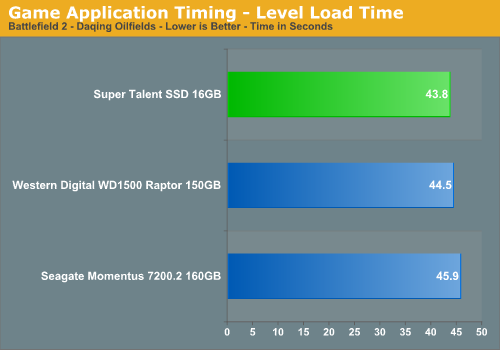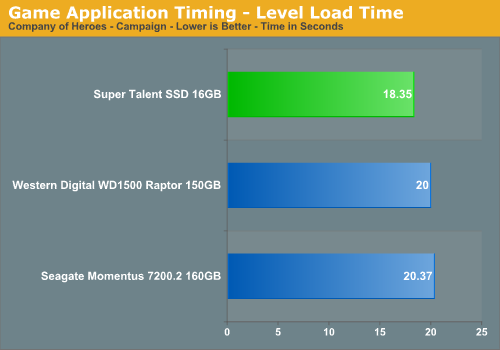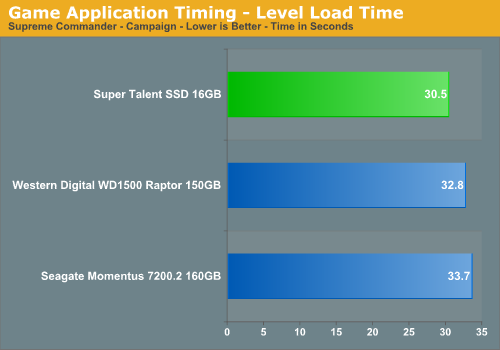Super Talent SSD: 16GB of Solid State Goodness
by Gary Key on May 7, 2007 4:00 AM EST- Posted in
- Storage
Actual Application Times - Gaming
Our application benchmarks are designed to show application performance results with times being reported in seconds, with lower scores being better. While these tests will show differences between the drives it is important to understand we are not measuring the synthetic performance of the hard drive but how well our platform performs with each individual drive. The performance of a drive is an integral part of the computer platform but other factors such as memory, CPU, core logic, and even driver choice can play a major role in determining how well the drive performs in any given task.
Game Level Load
Our tests center on the actual loading of a playable level within our game selections. It is obvious this drive is not intended to be used in gaming systems and we debated on even including these results. However, for game level loads the burst/sustained read speed and access time of a drive is very important. Considering Solid State Drives excel in low access (latency) times we thought it would be interesting to see how well this drive performed in our game tests.
The Battlefield 2 test measures the time it takes to load the Daqing Oilfields level. Our application timer begins when the start single player icon is initiated and ends when the join game icon is visible.

This is one of the more demanding game level load times we test and the Super Talent drive scores first although the margin is minimal. We fully expect the faster consumer level SSD products to improve upon these scores. After several hours of game play we could tell a slight difference between the drives in this test. The SSD product always seemed to load the levels in a smoother manner than our two hard disks, although it was difficult to determine any actual speed differences.
The Company of Heroes test measures the time it takes to load the first campaign level. Our application timer begins when the start single player icon is initiated and ends when the join game icon is visible.

Once again we see a minimal difference between our drives but the Super Talent drive is about 8% faster at loading this particular level. In repeated testing it was difficult to discern the differences between the drive setups but when compared to the Raptor the Super Talent drive is eerily quiet while playing the game. It took a little time to adjust to the acoustic differences not to mention our overall case temperatures being 3C lower after an hour of testing.
Our Supreme Commander test measures the time it takes to load the first campaign level. Our application timer begins when the start single player icon is initiated and ends when the join game icon is visible.

In our final game test the Super Talent drive is around 7% quicker at loading this particular campaign. We did not notice any issues throughout the full campaign scenario and as in the Battlefield 2 tests, the loading of the cut scenes and actual game levels was smoother although we did not perceive any differences in performance.
Our application benchmarks are designed to show application performance results with times being reported in seconds, with lower scores being better. While these tests will show differences between the drives it is important to understand we are not measuring the synthetic performance of the hard drive but how well our platform performs with each individual drive. The performance of a drive is an integral part of the computer platform but other factors such as memory, CPU, core logic, and even driver choice can play a major role in determining how well the drive performs in any given task.
Game Level Load
Our tests center on the actual loading of a playable level within our game selections. It is obvious this drive is not intended to be used in gaming systems and we debated on even including these results. However, for game level loads the burst/sustained read speed and access time of a drive is very important. Considering Solid State Drives excel in low access (latency) times we thought it would be interesting to see how well this drive performed in our game tests.
The Battlefield 2 test measures the time it takes to load the Daqing Oilfields level. Our application timer begins when the start single player icon is initiated and ends when the join game icon is visible.

This is one of the more demanding game level load times we test and the Super Talent drive scores first although the margin is minimal. We fully expect the faster consumer level SSD products to improve upon these scores. After several hours of game play we could tell a slight difference between the drives in this test. The SSD product always seemed to load the levels in a smoother manner than our two hard disks, although it was difficult to determine any actual speed differences.
The Company of Heroes test measures the time it takes to load the first campaign level. Our application timer begins when the start single player icon is initiated and ends when the join game icon is visible.

Once again we see a minimal difference between our drives but the Super Talent drive is about 8% faster at loading this particular level. In repeated testing it was difficult to discern the differences between the drive setups but when compared to the Raptor the Super Talent drive is eerily quiet while playing the game. It took a little time to adjust to the acoustic differences not to mention our overall case temperatures being 3C lower after an hour of testing.
Our Supreme Commander test measures the time it takes to load the first campaign level. Our application timer begins when the start single player icon is initiated and ends when the join game icon is visible.

In our final game test the Super Talent drive is around 7% quicker at loading this particular campaign. We did not notice any issues throughout the full campaign scenario and as in the Battlefield 2 tests, the loading of the cut scenes and actual game levels was smoother although we did not perceive any differences in performance.










44 Comments
View All Comments
eguy - Monday, May 14, 2007 - link
These guys are knowledgable and sell the Super Talent and other SSDs. They are even working on a RAID0 SSD box! http://www.dvnation.com/nand-flash-ssd.html">http://www.dvnation.com/nand-flash-ssd.html .There are not many SSDs that can benefit from RAID0. The issue is that the CONTROLLERS used IN these disks max out in speed before the NAND chips will. That means that the Samsung NAND chips while capable of 60+MB/S are throttled by a controller than in some cases will only do 25MB/S. In a hard disk, the media transfer rate is lower than the controller's bandwith. The hard disk controller can do 150MB/S+. So in hard drive land a 50MB/S hard disk + another 50MB/S hard disk = about 100MB/S in RAID0. But I've seen a 25MB/S SSD + 25MB/S SSD =, you ready for this? 17MB/S. DV Nation is predicting they will have a RAID0 box out later this year that can outperform a single SSD. They couldn't get the ultra-fast IDE Samsungs to RAID up. I told them I wanted to do 2X SATA SSDs in RAID and they said their customers had not had success with that.
I'm thinking newer models might in the future.
Also don't get bent out of shape between SATA and IDE in SSDs. IDEs are just as fast, if not faster than SATA. Even in the world of hard drives, IDE vs SATA does not matter in speed. Drive makers CHOOSE to make their fastest consumer drives in SATA, but even a 10 year old IDE interface is capable of 166MB/S, right? My 10,000 RPM SATA RAPTOR can only to 75MB/S, so IDE would be just as fast for it.
Modern SSDs will outlast hard disks. Forget the write cycles. They are rated between 1,000,000 and 5,000,000 write cycles. The problem is, hard disks are not rated in write cycles. For an apples to apples comparison, you need to use MTBF (mean time between failures). SSDs are rated much MUCH higher in that regard. Look at documentation on Sandisk's site, Samsungs, all the big manufacturers and independent reviewers. I've seen math done that shows life of up to 144 years! (!??!!)
Bladen - Tuesday, May 8, 2007 - link
I think many of us would be interested in seeing exactly what RAID 0 can do for these things. It would be good to compare 2x RAID 0 of this drive vs 2x RAID 0 of the Sandisk and/or Samsung ones, and compare that to 2x RAID Raptors too.Just be particularly flattering to Sandisk or Samsung to get another drive of them if you can.
abakshi - Tuesday, May 8, 2007 - link
If I recall, the price point for the current (OEM) SanDisk 32GB SSD is $350 in volume. If those (which are shipping in laptops today) have much better performance than this, why would anyone use this in an industrial/medical/etc. application - pay $150 more for 1/2 the space and a slower drive? Am I missing something here?Also, any idea of when are the SanDisk/Samsung/etc. consumer SSD's coming out?
PandaBear - Thursday, May 10, 2007 - link
Yeah, longer life span if you do not read/write a lot. HD wear out regardless of use but flash usually doesn't. Also, industrial environment don't usually use a lot of storage but have a lot of packaging limitation (can't fit a large HD or don't have enough cooling) that rule out HD.Check out Hitachi's Endurastar HD, they are rated for industrial grade but are more expensive and smaller capactiy. Now that is a better comparison.
MrGarrison - Wednesday, May 9, 2007 - link
Samsung's SSDs are already out. Check Newegg. They are even available here in Sweden.I would buy two of their 16GB SSDs if only they had SATA interface. Oh well, guess I'll have to wait a couple of months more.
Calin - Tuesday, May 8, 2007 - link
Interesting review, but I have a small problem with it:Please, compare the cost per gigabyte of the 2.5" SSD drive with the cost per gigabyte of other 2.5" mechanical hard drives.
While totally correct, the cost of $0.4/GB of current 3.5", high-capacity hard drives is much lower than the cost for the 2.5" mechanical hard drives (somewhere around the $1/GB, or slightly higher for low capacity drives).
The 16GB 2.5" SSD don't fit in the place of a Raptor, and a Raptor won't fit in the place of a SSD 16GB drive.
Thanks
bob4432 - Monday, May 7, 2007 - link
are the power requirements for the seagate 7200.2 correct - .87W / 2.42W?MadBoris - Monday, May 7, 2007 - link
I'm just very disappointed with performance on these for consumer PC usage.I mean this is solid state memory.
Somebody is going to break this wide open with performance someday, because flash is just so damn slow it's painful to write this.
Making a RAMDRIVE today (using a portion of system RAM) on our PC's is thousands fold faster only lacking volatility for persistent data.
Just duct tape some RAM sticks together on a PCB, hook a duracell to it and we should be good. ;) Well, you get the idea...We need to leverage performance of RAM today.
Wake me up when this technology gets interesting.
Shadar - Monday, May 7, 2007 - link
The article seems to imply that transfer rates are the problem with performance. In this case a RAID of 2 or 4 of these in RAID-0 would drastically increase performance. 4 of these in a Raid 0 should crush a standard hard drive as the transfer rate would always be higher and it would have blazing access times.Though I must wonder why the CF cards are not raided as it is inside this drive. Why wouldn't the manufacturer be using 4 4GB cards in a raid array to boost the speeds themselves inside the box?
yyrkoon - Monday, May 7, 2007 - link
Yeah sure, lets take something with an already severely limited lifespan, and decrease the lifespan by abusing it with RAID . . . Lets not forget that 4 of these drives would set you back over $2000, and it makes even less sense to do so.
I have done intesive testing in this area of my own, and to tell you the truth, *you* do not need that type of performance. *you*, of course meaning, you, me, or the next guy. Besides all this, if you really want to waste you money in the name of peformance, why dont you get 4x or more servers, capable of supporting 32 GB of memory each, use iSCSI, export 31GB of ram from each server, and RAID across those. If you're worried about redundancy, toss in a couple of Raptors into the initiator, and run RAID 0+1, or RAID 10 for redundancy . . .